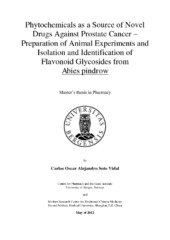| dc.description.abstract | Introduction: Plants and herbs have been utilized for centuries by traditional medicinal systems (e.g. TCM, Ayurveda) to alleviate minor illnesses and major diseases. In recent decades, interest in traditional medicine has increased significantly among drug development institutions. Currently, several research groups worldwide are conducting isolation, characterization and bioassay evaluation of secondary metabolites from plants and herbs utilized in traditional medicine. Such research aims to produce potential lead therapeutic compounds for future evaluation in preclinical animal models. Also terrestrial and marine organisms have been shown to produce biologically active secondary metabolites. In this Master’s thesis, key elements in the preparation of animal experiments for the evaluation of lead therapeutic compounds against adenocarcinoma of the prostate are presented. Thus, potential medicinal sources, prostate cancer animal models, pharmacology of humans and animals, study design, metastasis, monitoring techniques and ethical aspects are described. The practical part of this Master’s thesis is focused on the isolation and characterization of flavonoids from the branches and leaves of Abies pindrow. Previous purification of this plant species has been reported in the literature. Methodological considerations: Low-pressure column chromatography is dependent on four mechanisms of separation: adsorption, size-exclusion, partition and ion-exchange. Silica gel column chromatography is a form of adsorption chromatography. Sephadex LH-20 separates compounds mainly through size-exclusion, but adsorption can also be involved. Planar liquid chromatography comprises popular techniques such as TLC and PTLC, which are based on adsorption chromatography. MS and NMR are commonly employed in structure elucidation. MS is used to investigate molecular masses, while NMR describes the chemical environment of NMR active nuclei. Materials: A range of organic solvents were utilized in the isolation process. MeOH and CHCl3 were most often employed. Much of the work involved both TLC and PTLC plates. Sephadex LH-20 particles were employed more frequent than silica gel particles. The isolation process required equipment such as TLC and UV lamps, rotary evaporator and automatic fraction collector. MS and NMR analysis was performed to enable structure elucidation. Methods: Only simple chromatographic techniques were used. Analytical silica adsorbent TLC was employed throughout the isolation process. Silica adsorbent PTLC and polysaccharide size-exclusion chromatography were frequently employed. Silica gel column chromatography was only performed twice. Results and discussion: Nine compounds were initially isolated and purified. Two purified compounds were found to be the same prior to MS and NMR analysis, thus, only eight compounds were analyzed by MS and NMR. Out of these eight compounds, three were not pure enough to enable structure characterization and two were identified as the same compound on the basis of resulting spectra. Therefore, the isolation and identification of flavonoids from Abies pindrow yielded a total of four structurally dissimilar compounds. Conclusion: Four structurally dissimilar compounds were isolated through the use of simple chromatographic techniques and identified by MS and NMR analysis. All of the identified compounds belong to a class of plant secondary metabolites called flavonoids, or more specifically; flavonoid glycosides. They are known as: (1) kaempferol-3-O-(2ʹʹ, 4ʹʹ-di-E-p-coumaroyl)--L-rhamnopyranoside, (2) kaempferol-3-O--L-(4ʹʹ-E-p-coumaroyl)-rhamnoside, (3) quercitrin and (4) afzelin. Hopefully, investigation of these compounds on a molecular and cellular level will result in novel lead therapeutic compounds against cancer for future evaluation in animal models. | en_US |
